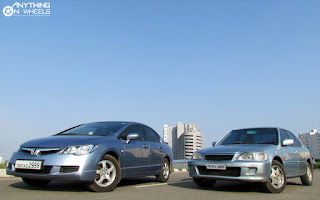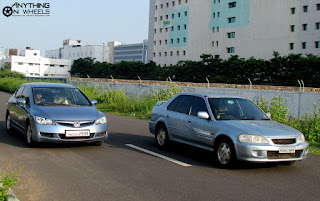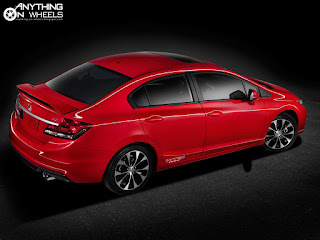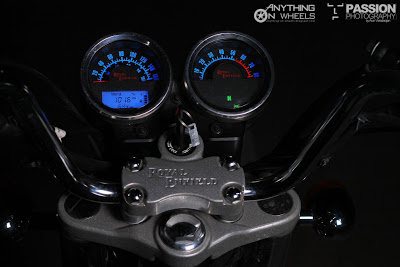A lazy Sunday afternoon is a great time for letting your thoughts run wild. Believe us, it works. It was on one such day, looking at two cars parked on the street, three of us car nuts, decided to go on an impromptu drive. It could have been a hasty decision but the cars are not just any other cars. It was on the merits of these two models that the reputation of a brand was built in India. Is building up a brand that important, you might ask? Ask Fiat, if in doubt.
Without getting into a suspense mode, the cars being referred to are the City VTEC and Civic, two glorious cars that define the brand 'Honda' to many in India.


The timing of this post couldn't be more precise too. Honda India is just recovering from a slump. Be it supply constraints due to natural calamities in Japan, shortage of knocked down kits due to floods in Thailand that crippled production, negative market sentiments and reduced sales due to the absence of diesel options in its line-up, massive price cuts in Jazz to clear stocks, you name a problem and they faced it.
All that is about to change with the all-new Amaze that's slated for launch early next year. But, let's not forget what made Honda famous, shall we?
TO LOOK AT:
As soon as we lined up both these cars together, we realized that they had more things in common than what we had initially thought. They both look classy and elegant, with bits of sportiness and aggression thrown in for good measure. The lines are so clean that we haven't grown tired of looking at them so many years after launch. In short, they impress without trying too hard.

The City VTEC came to India at a time when Mitsubishi Lancer was at its marauding best. The Lancer was the default choice of youngsters then and a main reason was its 'too-good-to-believe' stock looks and extremely mod-friendly nature. With the City VTEC, Honda nailed those two criteria and immediately captured the hearts of the enthusiasts. Though the basic design was similar to other variants of the City, the VTEC had a few exclusive touches like dual chrome-tipped exhaust pipes, a beautifully-crafted boot spoiler and those classic alloy wheels, that made the car stand out. The best part is that a well-maintained or nicely-modified example will attract stares even today.
The car that we drove, with its modified grille, projector headlights and smoked taillights, evoked positive reactions from passers-by. Not bad at all, for a car that was launched more than a decade back, we think. So, where does this leave the Civic that's accompanying the City VTEC?

That the Civic floored the media and the public alike when it was launched in 2006 isn't something that we don't know. The car was stunning and redefined the term 'modern'. It seemed that adjectives like sleek, aerodynamic and sporty existed just to define this car. The wrap-around headlights with its characteristic kink, the beautifully-sculpted fenders, pillars and wheel arches and the double-barrel taillights that extend into the boot looked like nothing else on the road.
Subtle chrome bits in grille, door handles, side strips and exhaust pipes lent a touch of class. On the whole, the Civic, with its different parts merging with each other seamlessly, was an astonishingly-beautiful sedan that was going to be hard to replace.
Not surprisingly then, six years after its launch, a year and half since the subsequent ninth generation model went on sale and with competition heating up, the Civic still manages to look hip and trendy, which speaks volumes on the incredibly modern design that this eighth generation Civic was bestowed with.
TO SIT IN:
Again, both these cars have quite a few things in common inside as well. First of all, you sit very low and it takes time to adjust, especially if you are used to sitting higher in other cars. Hondas are always known for their high quality interiors and impeccable fit and finish and both these cars stay true to that tradition. Unfortunately, both of them are victims of Honda's stinginess in features as well, a virtue that the company is slowly coming out of, now.
But that's where the similarity ends. While the City VTEC is all flat and rectangular, the Civic is all swoopy and angular. Step into the cars in close succession and you will witness the change that one generation, or about 5 years in a car's life cycle, can bring about.

Everything in the City VTEC screams old school, but that is only when compared to the Civic. Forget that the latter is around and you will realize that the City's interiors are in fact a lot better than many cars that were on sale at that time. The steering wheel, though a tad too large for the sporty nature of the car, provides a perfect line of vision to the instrument cluster that is dominated by large semi-circular speedometer and tachometer dials on either sides. The metallic silver inserts in the centre console, door pads and around the air-conditioning vents breaks the monotony of all-black interiors that was the norm. The car even came with electrically adjustable rear view mirrors, which was a luxury then.

Step out and get into the Civic and there is a world of difference, literally. The view from the driver's seat, that was exhilarating in 2006 when the car was first launched, still manages to excite. The large analog tachometer is flanked by tell-tale lights on both sides while the digital displays for speed, fuel level and engine temperature sit directly in our view of the road ahead. The center console is slightly angled towards the driver and is equipped with large buttons for controlling the climate control and audio system. The steering wheel is very small and sporty that is further accentuated by the metallic inserts. The handbrake lever is pure artistry and looks and feels great to touch and use.
Both cars came equipped with features that were par for the segment, though nowhere near what the best in segment offered. Just like the front seats, the rear seats are also set comparatively lower than other cars, but they score strongly in the 'comfort' factor. Civic's rear seat in particular is supremely comfortable and needs special mention. But with what is lying under the hood of these cars, the rear seats and their comfort isn't going to be a top priority.
TO DRIVE:
It's no exaggeration that the acronym 'VTEC' commands a crazy fan following, not just in India but across the world. Standing for Variable Valve Timing and Lift Electronic Control systems, Honda's VTEC engines offers a rare combination of power and economy by allowing the ECU to select from two cam profiles that are designed to maximize fuel-efficiency at lower RPMs and maximize power output at higher RPMs. Though it was the Honda Accord that introduced this technology to us Indians, it was the City that made it really popular with its much more affordable price tag. Civic uses a slightly modified version of the same technology, dubbed 'i-VTEC' or the "intelligent" VTEC that uses continuously varying cam profiles.

When it was launched in India, the City VTEC was nothing short of a revelation. Statistics like 100 bhp of power, acceleration from 0 to 100 km/h in 10 seconds and a top speed of 180 km/h were unheard of. Don't forget, those were the days when Maruti-Suzuki Esteem with all of 65 bhp was considered a powerful car.
Step in, get comfortable in the low-set driver's seat, floor the pedal and the jewel called VTEC under the hood takes care of the rest. The way in which the engine cleanly revs till its 7100 rpm redline is something that can't be described. Rather, it has to be experienced. There is no jerk, no drama, just brutal scoops of power transferred to the two front wheels. While the half-throttle responses at lower revs makes driving in the city a breeze, the strong surge at higher revs is a pleasure on the highways. The highly tractable nature of this engine is a quality that we love in the City VTEC. Forget about fuel-efficiency, this engine is addictive, one that isn't harmful for a change.
Adding to the driving experience is the sharp steering that weighs up nicely. The ride is firm courtesy the low profile tires that the car comes shod with. Handling is great and the car sticks to the road as long as you maintain a sedate pace. Stability at three digit speeds isn't confidence inspiring and the car tends to float and wallow at high speeds.


Civic, on the other hand, is a total contrast to the City VTEC. It struggles in bumper-to-bumper city traffic with a poor throttle response at low revs. The gears and clutch needs to be worked upon constantly and the car shudders when forced to move from standstill in second gear. Keep the engine on the boil at above 1800 rpm though and the Civic is a different animal altogether. A surge is experienced once the tacho needle blasts past 2000 rpm and it continues all the way to its 6800 rpm redline. Power delivery is more linear and the Civic doesn't feel as quick or as dramatic as it's younger sibling. Its calm, its composed and its way more mature than the City VTEC.
Whatever the Civic loses to City VTEC in terms of urban driveability, it gains with its cruising ability on the highways. The ride is still firm and the rear suspension is way too soft for our liking. But the handling is brilliant and high-speed stability is simply superb. The Civic would be happy munching miles as long as the roads are decent enough, with its soft rear suspension and low ground clearance requiring constant attention over broken patches.
Both the cars are extremely fuel-efficient if you keep the engine running at lower revolutions. We know it's tough, but do that and you will be amazed by the figures that they return. Don't believe us? Get this. When driven consistently at 2000 rpm at an average speed of 80 km/h over a distance of 300 km, the Civic returned an astonishing 17.5 km/l, which is nothing but sheer magic for a free-revving 1.8-liter engine that runs on petrol.
SPECIFICATIONS:


CITY VTEC:
* Engine Type: In-line, SOHC, VTEC
* No of Cylinders: 4
* Displacement: 1493 cc
* Maximum Power: 106 bhp @ 6800 rpm
* Maximum Torque: 13.5 kgm @ 4700 rpm
* Transmission Type: 5-speed MT
* Tires: 175/65 R14
* Brakes: Ventilated Disc (Front), Drum (Rear)
CIVIC (1.8 S):
* Engine Type: In-line, DOHC, i-VTEC
* No of Cylinders: 4
* Displacement: 1799 cc
* Maximum Power: 130 bhp @ 6300 rpm
* Maximum Torque: 17.5 kgm @ 4300 rpm
* Transmission Type: 5-speed MT
* Tires: 195/65 R15
* Brakes: Disc (Front & Rear)
VERDICT:


Having driven both these cars extensively, its not hard to understand the reason for automotive enthusiasts showering their love on Honda. Times may have changed and competition might have surged past. But, in the not-so-distant past, there was no other manufacturer who could make powerful, free-revving yet fuel-efficient petrol engines as good as Honda. Combine with that good looks, class-leading interior quality, spacious interiors, comfortable ride quality, sporty handling and rock-solid reliability and you get the perfect recipe for success. The City VTEC might have been discontinued long back but there is a reason why it is so hard to find in the pre-owned market. Those who own one just don't want to part with the car. The Civic though is still on sale. Go get one and relish the VTEC experience for all your money's worth.
Having reveled in the i-VTEC experience once again, we now brace ourselves for 'i-DTEC'. Don't scratch your heads. It's the new family of small diesel engines being developed by Honda under "Earth Dreams" branding. The Amaze sedan, that's based on the Brio hatchback and slated for launch in 2013, will be the first car to get this engine.

























































